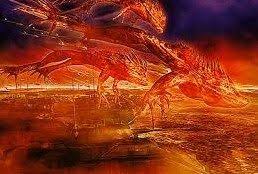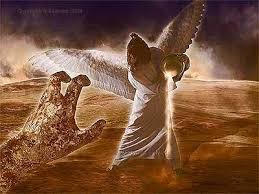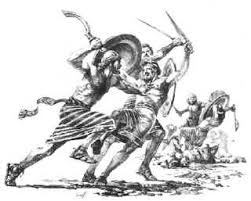Eg – El sexto ángel derramó su copa… y vi tres espíritus inmundos como ranas 16: 12-16
El sexto ángel derramó su copa
…y vi tres espíritus inmundos como ranas
16: 12-16
El sexto ángel derramó su copa… y vi tres espíritus inmundos como ranas ESCUDRIÑAR: ¿Qué harán los espíritus inmundos para reunir hombres para la Campaña del Armagedón? ¿Cómo convergerán finalmente los propósitos justos del SEÑOR y los propósitos malvados de Satanás en esta próxima Campaña?
REFLEXIONAR: ¿Cuáles son las ranas que luchan con usted? ¿Cómo va la batalla? ¿Cómo le hace sentir el libro de Apocalipsis? ¿Por qué? ¿Qué le ha sorprendido del Señor o de este libro? ¿Cómo explicaría la necesidad de estas plagas a alguien que no cree en Dios?
El sexto derramó su copa sobre el gran río Éufrates, y se secó su agua, para que se preparara el camino de los reyes que vienen del oriente (16:12). Los juicios de la sexta y séptima copa no están en orden cronológico. Son como dos sujeta libros que describen la primera y última etapa de la Campaña de Armagedón. Para ver un resumen de esta campaña, y donde el río Éufrates es secado y como encaja en este contexto, haga clic en el enlace y vea Ex – Las ocho etapas de la campaña de Armagedón.
Al igual que los otros apagones mundiales en los últimos tiempos, no sabemos cuánto durarán ellos. Pero eventualmente el cuarto apagón termina y el sexto ángel derramará su copa sobre el gran río Éufrates. El Éufrates ha sido una parte integral de los asuntos mundiales desde su creación. Fue uno de los cuatro ríos que regaron el jardín del Edén (Génesis 2:14). Se suponía que debía proporcionar los límites norte y este de la tierra que Dios prometió a los descendientes de Abraham (Génesis 15:18; Josué 1:4). Los israelitas simplemente lo llamaron el río o el gran río. El nombre griego, Éufrates, significaba agua dulce. Pero cerca del final de la Gran Tribulación, esas aguas, durante mucho tiempo amargadas por el juicio, se secarán.
Querido Abba Padre (Mateo 6:9), ¡Alabamos Tu poder y amor! ¡Eres nuestra Agua Viva que nunca se secará! En el último día, el más grande de la fiesta, Jesús se puso en pie, y alzando la voz, dijo: ¡Si alguno tiene sed, venga a mí y beba! El que cree en mí, como dijo la Escritura, de su vientre fluirán ríos de agua viva. Esto dijo acerca del Espíritu que iban a recibir los que creyeran en Él, porque todavía no había Espíritu, pues Jesús no había sido aún glorificado (Juan 7:37-39). Te alabo porque enviaste al Espíritu Santo (Ruaj HaKodesh) a vivir en Tus hijos. Y por Tu mismo poder que levantó a Yeshua de entre los muertos, Tú también levantarás a todos Tus hijos. Pero si el Mesías está en vosotros, el cuerpo a la verdad está muerto a causa del pecado, pero el espíritu vivo a causa de la justicia (Romanos 8:10). No se turbe vuestro corazón; creed en Dios, creed también en mí. En la casa de mi Padre muchas moradas hay; si no, os lo hubiera dicho; voy, pues, a preparar lugar para vosotros. Y cuando me vaya y os prepare lugar, vengo otra vez y os tomaré a mí mismo, para que donde Yo estoy, vosotros también estéis (Juan 14: 1-3). Te amamos y nos postramos para adorarte. Te alabamos por hacer un hogar en el cielo para Tus hijos. En el nombre de tu santo Hijo y el poder de la resurrección. Amén.
Y se secó su agua, para que se preparara el camino de los reyes que vienen del oriente (16:12b). El gran río Éufrates es uno de los grandes ríos del mundo. Pero debido a que las plagas son acumulativas, el Éufrates seguirá lleno de sangre y peces muertos. La sequía de tres años y medio de la primera mitad de la Gran Tribulación seguramente disminuyó el flujo de agua incluso antes de que los ríos del mundo se convirtieran en sangre por la tercera copa del juicio (16:4). Este proceso de secado tendrá el propósito de facilitar que el anticristo reúna sus fuerzas y comenzará la Campaña de Armagedón. La acción del SEÑOR en el TaNaJ se asocia frecuentemente con el secado de las aguas, como se ve en el Mar Rojo (Éxodo 14:21), el Jordán (Josué 3:16), y varias veces en las profecías (Isaías 11:15-16, 44:27 y 51:10; Jeremías 51:36; Zacarías 10:11).371
Estos no son doscientos millones de chinos, sino demonios (haga clic en el enlace y vea Db – La sexta trompeta: los cuatro ángeles que habían sido preparados, fueron liberados para matar a un tercio de la humanidad). Los doscientos millones (9:16) y los reyes del oriente pertenecen a dos juicios diferentes que deben mantenerse distintos y no pueden combinarse. En todas partes de la Biblia, el oriente (o el este) siempre se refiere a Mesopotamia (Asiria y Babilonia). Debido a que la capital del anticristo estará en Babilonia (17:18), da fe del hecho de que los reyes que vendrán desde el este, son reyes mesopotámicos. Aparentemente habían estado ansiosos por moverse hacia el oeste y unirse a la batalla. Poco sabían, que su afán de reunirse en el Valle de Jezreel con el anticristo no será de su propia elección, sino más bien el resultado del engaño demoníaco. La bestia dará un decreto. Él ordenará a sus aliados que reúnan a sus ejércitos. Esta campaña final contra Jesús y los judíos es ciertamente el trabajo de la trinidad falsa. La convocatoria se verá reforzada por la actividad demoníaca para asegurar que las naciones realmente cooperarán en la formación de sus ejércitos. Estos son los siete reyes que se han mantenido bajo la autoridad del anticristo desde la mitad de la Gran Tribulación (vea Dk – Tres reyes son asesinados y siete se someten).
 Y vi salir de la boca del dragón, y de la boca de la bestia, y de la boca del falso profeta, tres espíritus inmundos como ranas (16:13). Entonces vinieron tres espíritus malignos, del dragón, la bestia y del falso profeta, que parecían ranas. Las ranas eran animales inmundos (Levítico 11:10 y 41), pero estas no eran ranas literales como en la plaga en Egipto (vea el comentario sobre Éxodo Bl: Estira tu mano y haz que las ranas suban a la tierra de Egipto), sino que salieron de sus bocas. Juan los identificó como espíritus de demonios que hacen señales prodigiosas. No es sorprendente que esos demonios tengan tan grandes poderes de engaño. Jesús predijo se levantarán falsos mesías y falsos profetas, y darán señales y prodigios, a fin de extraviar, si fuera posible, a los escogidos (Marcos 13:22; Segunda Tesalonicenses 2:9-10). Ciertamente, esos demonios tendrán grandes poderes de engaño. Por lo tanto, tendrán pocas dificultades para engañar, pues son espíritus de demonios que hacen señales prodigiosas, los cuales van a los reyes de toda la tierra habitada, a fin de reunirlos para la batalla del gran día del Dios Todopoderoso (16:14). Ese gran día es la Campaña de Armagedón.372 Mientras que el Señor nunca es el autor del mal, Él permitirá que la gente mala se destruya a sí misma por sus propios malos actos (Romanos 1:20-32).
Y vi salir de la boca del dragón, y de la boca de la bestia, y de la boca del falso profeta, tres espíritus inmundos como ranas (16:13). Entonces vinieron tres espíritus malignos, del dragón, la bestia y del falso profeta, que parecían ranas. Las ranas eran animales inmundos (Levítico 11:10 y 41), pero estas no eran ranas literales como en la plaga en Egipto (vea el comentario sobre Éxodo Bl: Estira tu mano y haz que las ranas suban a la tierra de Egipto), sino que salieron de sus bocas. Juan los identificó como espíritus de demonios que hacen señales prodigiosas. No es sorprendente que esos demonios tengan tan grandes poderes de engaño. Jesús predijo se levantarán falsos mesías y falsos profetas, y darán señales y prodigios, a fin de extraviar, si fuera posible, a los escogidos (Marcos 13:22; Segunda Tesalonicenses 2:9-10). Ciertamente, esos demonios tendrán grandes poderes de engaño. Por lo tanto, tendrán pocas dificultades para engañar, pues son espíritus de demonios que hacen señales prodigiosas, los cuales van a los reyes de toda la tierra habitada, a fin de reunirlos para la batalla del gran día del Dios Todopoderoso (16:14). Ese gran día es la Campaña de Armagedón.372 Mientras que el Señor nunca es el autor del mal, Él permitirá que la gente mala se destruya a sí misma por sus propios malos actos (Romanos 1:20-32).
Satanás, sabiendo que la Segunda Venida del Mesías está cerca, reunirá el poderío militar del mundo en el Valle de Jezreel para resistir la venida del Hijo del Hombre que regresará al Monte de los Olivos (Zacarías 14:4). Aunque las naciones pueden ser engañadas al entrar en la guerra con la esperanza de ganar el poder político mundial, el propósito satánico es combatir a los ejércitos del cielo en la Segunda Venida (19:14).373
El tren de pensamiento ahora es interrumpido por un comentario entre paréntesis que contiene un mensaje de consuelo y esperanza. Jesús dirá: He aquí vengo como ladrón. Bienaventurado el que vela y guarda sus ropas, no sea que ande desnudo y vean su vergüenza (16:15). Él vendrá rápida e inesperadamente. A pesar de que los corazones de todos los de la tierra en ese momento serán reprobados por completo como el faraón de Egipto, Su declaración aquí será un último intento para que cualquiera que lo acepte a Él, escape del juicio venidero, no queriendo que ninguno perezca (Segunda Pedro 3:9a). Jesús (Yeshua) dice: Bienaventurado el que vela y guarda sus ropas (16:15a). Esta es la tercera de las siete bendiciones en el libro de Apocalipsis (1:3, 14:13, 16:15, 19:9, 20:6, 22:7, 22:14). Esa persona será completamente irreprensible (Hechos 24:16). Nadie será capaz de estar delante de Cristo en el juicio del Gran Trono Blanco, y cuando es sentenciado a una eternidad en el infierno, agitar un puño hacia Él y decir: “Usted no es justo, nunca he tenido una oportunidad.”
Luego, después de que Jesús (Yeshua) advierte a los incrédulos que acepten Su última oferta de gracia antes de que sea demasiado tarde, Juan regresa a los eventos del juicio de la sexta copa. Y los reunió en el lugar que en hebreo se llama Armagedón (16:16). La palabra Armagedón en hebreo es Har Meguido [monte Meguido]. Meguido era una ciudad estratégica ubicada en el extremo occidental del Valle de Jezreel, protegiendo el famoso Paso de Meguido en el valle más grande de Israel (Jueces 5:19; Segunda Reyes 23:29-30; Segunda Crónicas 35:22; Zacarias 12:11). Guardó un paso importante en la antigua Via Maris o Camino del Mar, conectando Egipto y Siria. Uno puede ver todo el Valle de Jezreel desde la montaña sobre la que se encontraba la ciudad de Meguido. Había visto muchas batallas y mucho luto. Entonces, lo que se conoce como el Valle del Armagedón es en realidad el Valle bíblico de Jezreel. El término Armagedón nunca se aplica al valle en sí, sino solo a la montaña en el extremo occidental. Aquí, en el gran valle de la Baja Galilea, los ejércitos del mundo se reunirán con el propósito de destruir a todos los judíos que aún viven en ese momento.
Cabe señalar que el pasaje no dice nada de una batalla en este valle, ya que allí no se librarán combates. El Valle de Jezreel, custodiado por la Montaña de Meguido, servirá simplemente como lugar de reunión para los ejércitos del anticristo. Armagedón jugará un papel similar al de Inglaterra en las etapas finales de la Segunda Guerra Mundial. Las fuerzas aliadas reunieron sus ejércitos en Inglaterra, pero la batalla tuvo lugar en las playas de Normandía en Francia. Los ejércitos del anticristo se reunirán en el Valle de Armagedón, pero la Campaña de Armagedón en realidad comenzará en Bosra, continuará por el Valle de Josafat y terminará cuando los pies de Jesús se paren en el Monte de los Olivos en Jerusalén; vea Zacarías 14:3-4. Esto hará que la ciudad de Jerusalén se divida en tres partes (vea Ex – La Campaña de las Ocho Etapas de Armagedón).
Este pasaje es visto desde la perspectiva del hombre, que es simplemente una reunión militar convocada por el anticristo. Pero en la perspectiva del Señor es bastante diferente. El SEÑOR proclamará entre las naciones: ¡Declarad la guerra santa, Despertad a los valientes! Todos los hombres de guerra: ¡Acérquense y suban! De los arados forjad espadas, Y de vuestras hoces haced lanzas. Diga el débil: ¡Fuerte soy! ¡Apresuraos y venid, Naciones todas de alrededor, reuníos allí! ¡Oh YHVH, haz que bajen tus valientes! ¡Alértense las naciones y vengan al valle de Josafat, Porque allí me sentaré para juzgar a todas las naciones en derredor! (Joel 3:9b-12).
Dios se burla de ellos. Se alienta burlonamente a las naciones a prepararse para la guerra. Para aquellos que son débiles, y que piensan que en realidad son fuertes. Porque mientras Satanás, el anticristo y el falso profeta reúnen a las naciones con el propósito de destruir a los judíos, ADONAI tiene Su propio propósito, muy diferente, de permitir que la reunión tenga lugar.
Esta burla de la reunión de las naciones también se describe en el Salmo 2:1-6: ¿Para qué se sublevan las naciones, Y los pueblos traman cosas vanas? Se alzarán los reyes de la tierra, Y con príncipes consultarán unidos, Contra YHVH y contra su Ungido, diciendo: ¡Rompamos sus ligaduras Y echemos de nosotros sus cuerdas! El que se sienta en los cielos se sonreirá, Adonay se burlará de ellos. Luego les hablará en su ardiente ira, Los aterrorizará en su indignación. Yo mismo he ungido a mi Rey sobre Sión, mi santo monte.
Desde el punto de vista de ADONAI, la reunión de las naciones se presenta como una reunión contra ÉL y Su Mesías ungido. Al tratar de destruir a los judíos, la niña de sus ojos, Satanás también busca romper el control de Dios sobre el mundo. ¡Qué tonto! Entonces ADONAI es representado como sentado en los cielos riéndose, porque Él pronto pondrá a las naciones gentiles en confusión. Es el SEÑOR quien pondrá a su propio rey en Sión, y Satanás, el anticristo y el falso profeta no podrán detenerlo. Aunque las naciones se reunirán para matar a todos los judíos que quedan en el mundo, sin darse cuenta lograrán el propósito de Dios. La reunión de los ejércitos de las naciones gentiles en el Valle de Jezreel será la primera etapa de la Campaña de Armagedón.374



 El quinto derramó su copa sobre el trono de la bestia, y su reino fue entenebrecido, y se mordían de dolor la lengua (16:10). Ahora el quinto ángel derramará su copa de la ira, esta vez derramando su contenido sobre el trono de la misma bestia, y su reino se oscurecerá. La Biblia es muy clara que este juicio se iniciará en el mismo trono de la bestia. Pero la Escritura también es muy clara acerca de que
El quinto derramó su copa sobre el trono de la bestia, y su reino fue entenebrecido, y se mordían de dolor la lengua (16:10). Ahora el quinto ángel derramará su copa de la ira, esta vez derramando su contenido sobre el trono de la misma bestia, y su reino se oscurecerá. La Biblia es muy clara que este juicio se iniciará en el mismo trono de la bestia. Pero la Escritura también es muy clara acerca de que  Después de la breve defensa de los juicios del SEÑOR por el tercer ángel, el cuarto ángel miró hacia la tierra, donde aquellos que habían tomado la marca de la bestia esperaban expectantes a que la lluvia apagara su sed. Pero, en cambio: El cuarto (ángel) derramó su copa sobre el sol, y le fue dado quemar a los hombres con fuego (16:8). El sol fue creado para sostener la vida (Génesis 1:14-19), y desde el cuarto día de la creación, el sol había sido un buen servidor tanto para la humanidad como para la tierra. Sin embargo, durante
Después de la breve defensa de los juicios del SEÑOR por el tercer ángel, el cuarto ángel miró hacia la tierra, donde aquellos que habían tomado la marca de la bestia esperaban expectantes a que la lluvia apagara su sed. Pero, en cambio: El cuarto (ángel) derramó su copa sobre el sol, y le fue dado quemar a los hombres con fuego (16:8). El sol fue creado para sostener la vida (Génesis 1:14-19), y desde el cuarto día de la creación, el sol había sido un buen servidor tanto para la humanidad como para la tierra. Sin embargo, durante  El tercero derramó su copa en los ríos y las fuentes de aguas, y se convirtió en sangre (16:4). Cuando las personas malvadas de la tierra tambalearon al darse cuenta de que sus vidas estaban siendo destrozadas por el mar envenenado, se volvieron hacia el interior con la esperanza de encontrar agua potable en los ríos y lagos. Pero justo cuando estaban a punto de consolarse, el tercer ángel derramó su copa, y el mismo terrible juicio que afectó al mar también cayó a los ríos y las fuentes de aguas y también se convirtieron en sangre (Apocalipsis 16:4; Éxodo 7:17-21; Salmo 78:44). El juicio de la tercera copa será peor que el juicio de la tercera trompeta.
El tercero derramó su copa en los ríos y las fuentes de aguas, y se convirtió en sangre (16:4). Cuando las personas malvadas de la tierra tambalearon al darse cuenta de que sus vidas estaban siendo destrozadas por el mar envenenado, se volvieron hacia el interior con la esperanza de encontrar agua potable en los ríos y lagos. Pero justo cuando estaban a punto de consolarse, el tercer ángel derramó su copa, y el mismo terrible juicio que afectó al mar también cayó a los ríos y las fuentes de aguas y también se convirtieron en sangre (Apocalipsis 16:4; Éxodo 7:17-21; Salmo 78:44). El juicio de la tercera copa será peor que el juicio de la tercera trompeta.  Una de las razones por la que los juicios de las copas serán tan devastadores es que sus efectos serán acumulativos. Antes de que las llagas de la primera copa pudieran sanar: El segundo derramó su copa sobre el mar, el cual se convirtió en sangre como de muerto, y murió todo ser vivo de los que están en el mar (16:3). Para asombro, horror y desesperación del mundo, los océanos ya no serán fluidos, sino que se volverán gruesos, oscuros y coagulados, como el charco de sangre de alguien que ha sido apuñalado hasta la muerte.358 El juicio de la segunda copa será peor que el juicio de la segunda trompeta. Contaminará el mar convirtiéndolo en sangre y matando todo lo que contiene. Debido a la destrucción de gran parte del ecosistema de la tierra, con la sequía y las hambrunas, el mar se convertirá en una fuente extremadamente importante de alimentos. Entonces, uno puede ver que esto sería un tremendo juicio mundial.359
Una de las razones por la que los juicios de las copas serán tan devastadores es que sus efectos serán acumulativos. Antes de que las llagas de la primera copa pudieran sanar: El segundo derramó su copa sobre el mar, el cual se convirtió en sangre como de muerto, y murió todo ser vivo de los que están en el mar (16:3). Para asombro, horror y desesperación del mundo, los océanos ya no serán fluidos, sino que se volverán gruesos, oscuros y coagulados, como el charco de sangre de alguien que ha sido apuñalado hasta la muerte.358 El juicio de la segunda copa será peor que el juicio de la segunda trompeta. Contaminará el mar convirtiéndolo en sangre y matando todo lo que contiene. Debido a la destrucción de gran parte del ecosistema de la tierra, con la sequía y las hambrunas, el mar se convertirá en una fuente extremadamente importante de alimentos. Entonces, uno puede ver que esto sería un tremendo juicio mundial.359 Salió el primero, y derramó su copa sobre la tierra, y sobrevino una úlcera maligna y pestilente sobre los hombres que tienen la marca de la bestia y que adoran su imagen (16:2). Esto nos recuerda a las plagas en Egipto (ver el comentario sobre
Salió el primero, y derramó su copa sobre la tierra, y sobrevino una úlcera maligna y pestilente sobre los hombres que tienen la marca de la bestia y que adoran su imagen (16:2). Esto nos recuerda a las plagas en Egipto (ver el comentario sobre 













